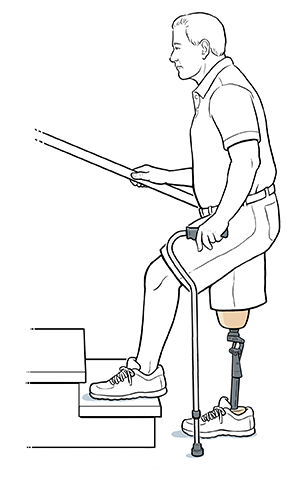Learning to walk with your prosthesis takes practice. To prevent falls, you may need a cane for balance and support. Work with your physical therapist (PT) and prosthetist (an expert who makes and fits your prosthesis). They’ll teach you how to use the cane correctly. They'll also help select which cane is best for you. There are several types of canes available: standard, offset, and quadripod. Follow all instructions from the PT and prosthetist closely.
Walking with a cane
-
Hold the cane on the side of your intact limb, unless told otherwise by your healthcare team.
-
Put your weight on your intact limb and find your balance.
-
Move the cane and the prosthetic limb forward at the same time.
-
Support your weight on both the cane and your prosthesis.
-
Step through with your intact limb.
-
Put your weight on your intact limb and take the next step, using the cane and your prosthesis.
Using steps
-
If there's a railing, hold on to it with your free hand.
-
Step up with your intact limb first.
-
Then move the cane and prosthetic limb together to the same step as your intact limb.
-
To walk down steps, hold the railing with your free hand.
-
Step down with your prosthetic limb and the cane first.
-
Then follow with your intact limb to the same step.
Note: Consult with your PT and prosthetist to learn how to handle steps without railings.
Home safety tips
Making a few changes at home can reduce hazards and help prevent falls. Ask a family member or friend to make these changes before you go home:
-
Remove objects that could cause you to trip, such as area rugs, thresholds, or loose cords.
-
Store supplies between waist and shoulder level. This will help you maintain balance as you reach for things.
-
Make sure all rooms are well lit.
-
Move all electrical cords out of the way or tape them securely to the floor.
-
Pick up clutter. Keep floors clear at all times.
-
Reduce stair use by making the most of each trip. Do more than 1 task per trip.


